Knowledge Management Solution: A Report on OECC Australia
VerifiedAdded on 2023/06/11
|11
|2612
|337
Report
AI Summary
This report addresses the knowledge management issues faced by Overseas Education and Career Consultant (OECC) Australia, specifically the lack of cross-departmental interaction that inhibits effective knowledge sharing. The proposed solution involves implementing a blended knowledge management approach, utilizing IT tools such as an intranet and personal networks to foster better communication and knowledge dissemination among departments. The report details the steps for knowledge sharing, internalization, and creation, aiming to enhance the quality of information provided to overseas students. Expected outcomes include improved departmental interaction, increased student base, and a more efficient knowledge management process. The report concludes that effective knowledge management is crucial for educational consultants like OECC and outlines strategies for overcoming implementation challenges.
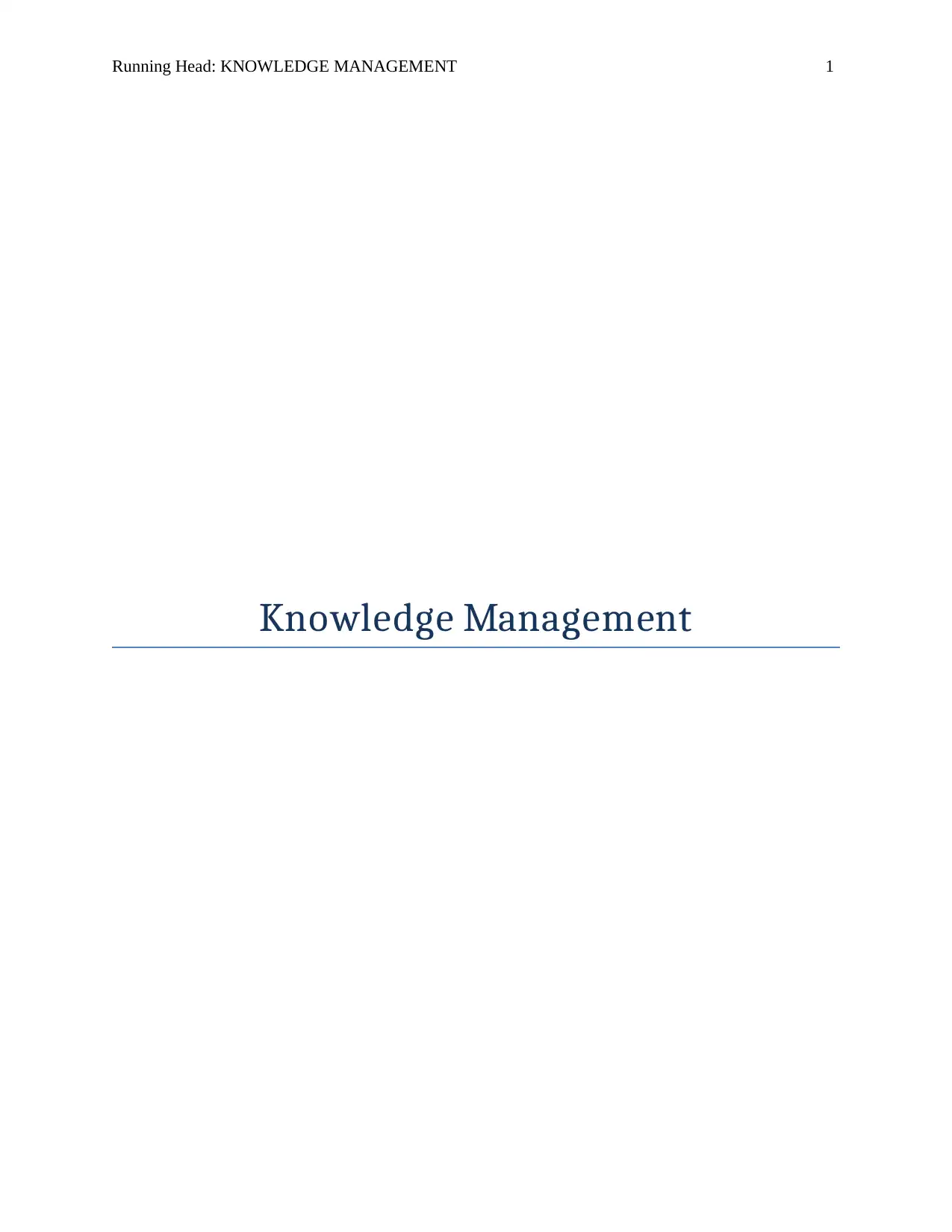
Running Head: KNOWLEDGE MANAGEMENT 1
Knowledge Management
Knowledge Management
Paraphrase This Document
Need a fresh take? Get an instant paraphrase of this document with our AI Paraphraser
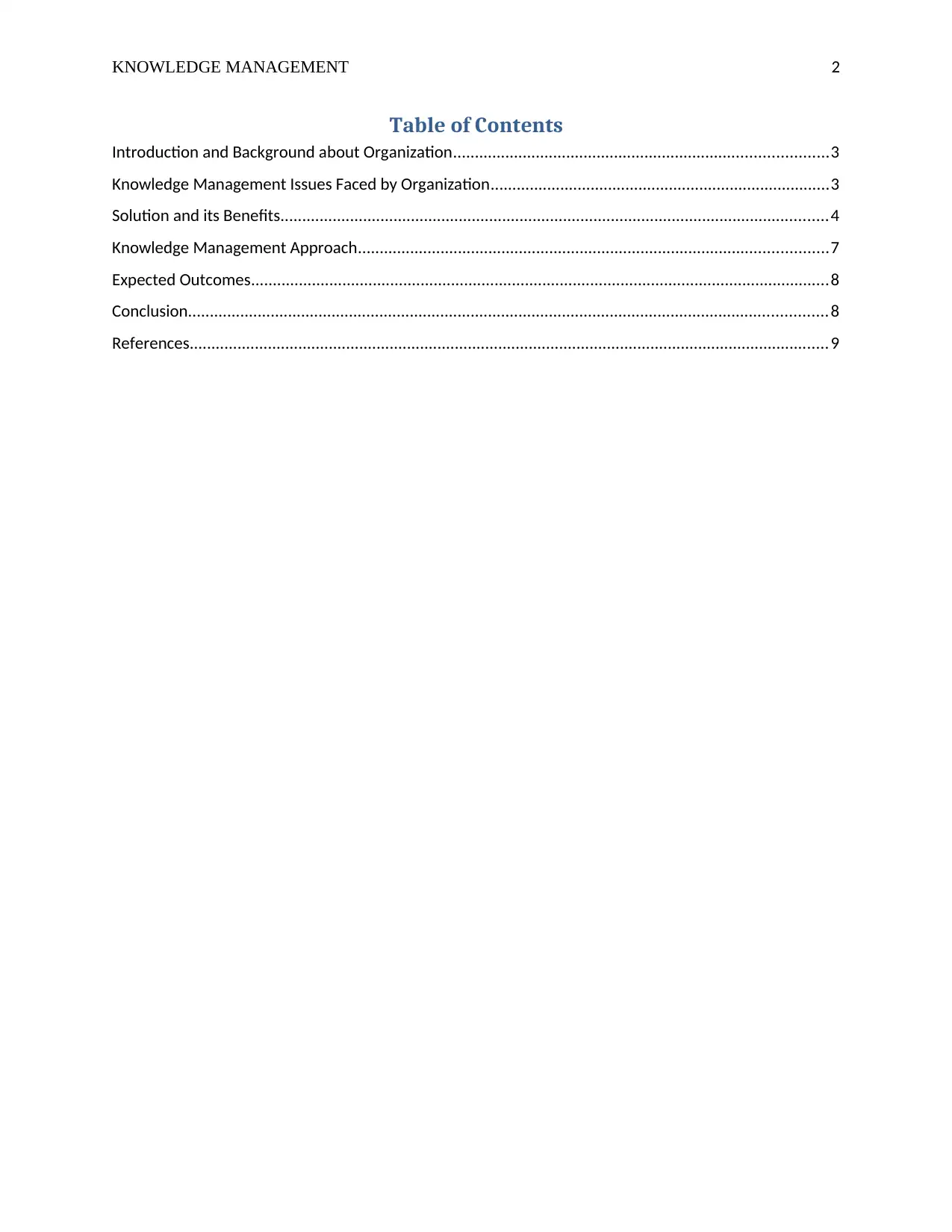
KNOWLEDGE MANAGEMENT 2
Table of Contents
Introduction and Background about Organization......................................................................................3
Knowledge Management Issues Faced by Organization..............................................................................3
Solution and its Benefits..............................................................................................................................4
Knowledge Management Approach............................................................................................................7
Expected Outcomes.....................................................................................................................................8
Conclusion...................................................................................................................................................8
References...................................................................................................................................................9
Table of Contents
Introduction and Background about Organization......................................................................................3
Knowledge Management Issues Faced by Organization..............................................................................3
Solution and its Benefits..............................................................................................................................4
Knowledge Management Approach............................................................................................................7
Expected Outcomes.....................................................................................................................................8
Conclusion...................................................................................................................................................8
References...................................................................................................................................................9
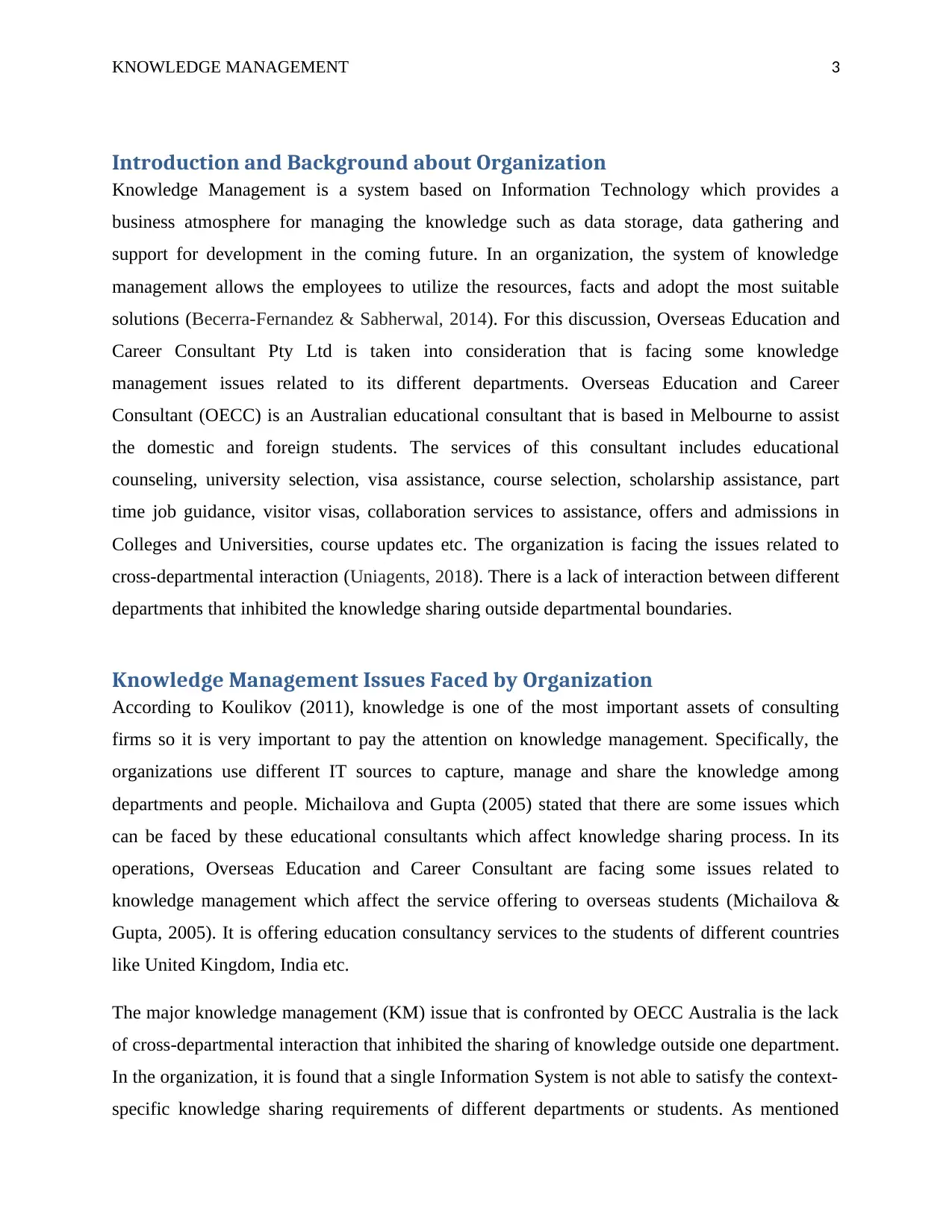
KNOWLEDGE MANAGEMENT 3
Introduction and Background about Organization
Knowledge Management is a system based on Information Technology which provides a
business atmosphere for managing the knowledge such as data storage, data gathering and
support for development in the coming future. In an organization, the system of knowledge
management allows the employees to utilize the resources, facts and adopt the most suitable
solutions (Becerra-Fernandez & Sabherwal, 2014). For this discussion, Overseas Education and
Career Consultant Pty Ltd is taken into consideration that is facing some knowledge
management issues related to its different departments. Overseas Education and Career
Consultant (OECC) is an Australian educational consultant that is based in Melbourne to assist
the domestic and foreign students. The services of this consultant includes educational
counseling, university selection, visa assistance, course selection, scholarship assistance, part
time job guidance, visitor visas, collaboration services to assistance, offers and admissions in
Colleges and Universities, course updates etc. The organization is facing the issues related to
cross-departmental interaction (Uniagents, 2018). There is a lack of interaction between different
departments that inhibited the knowledge sharing outside departmental boundaries.
Knowledge Management Issues Faced by Organization
According to Koulikov (2011), knowledge is one of the most important assets of consulting
firms so it is very important to pay the attention on knowledge management. Specifically, the
organizations use different IT sources to capture, manage and share the knowledge among
departments and people. Michailova and Gupta (2005) stated that there are some issues which
can be faced by these educational consultants which affect knowledge sharing process. In its
operations, Overseas Education and Career Consultant are facing some issues related to
knowledge management which affect the service offering to overseas students (Michailova &
Gupta, 2005). It is offering education consultancy services to the students of different countries
like United Kingdom, India etc.
The major knowledge management (KM) issue that is confronted by OECC Australia is the lack
of cross-departmental interaction that inhibited the sharing of knowledge outside one department.
In the organization, it is found that a single Information System is not able to satisfy the context-
specific knowledge sharing requirements of different departments or students. As mentioned
Introduction and Background about Organization
Knowledge Management is a system based on Information Technology which provides a
business atmosphere for managing the knowledge such as data storage, data gathering and
support for development in the coming future. In an organization, the system of knowledge
management allows the employees to utilize the resources, facts and adopt the most suitable
solutions (Becerra-Fernandez & Sabherwal, 2014). For this discussion, Overseas Education and
Career Consultant Pty Ltd is taken into consideration that is facing some knowledge
management issues related to its different departments. Overseas Education and Career
Consultant (OECC) is an Australian educational consultant that is based in Melbourne to assist
the domestic and foreign students. The services of this consultant includes educational
counseling, university selection, visa assistance, course selection, scholarship assistance, part
time job guidance, visitor visas, collaboration services to assistance, offers and admissions in
Colleges and Universities, course updates etc. The organization is facing the issues related to
cross-departmental interaction (Uniagents, 2018). There is a lack of interaction between different
departments that inhibited the knowledge sharing outside departmental boundaries.
Knowledge Management Issues Faced by Organization
According to Koulikov (2011), knowledge is one of the most important assets of consulting
firms so it is very important to pay the attention on knowledge management. Specifically, the
organizations use different IT sources to capture, manage and share the knowledge among
departments and people. Michailova and Gupta (2005) stated that there are some issues which
can be faced by these educational consultants which affect knowledge sharing process. In its
operations, Overseas Education and Career Consultant are facing some issues related to
knowledge management which affect the service offering to overseas students (Michailova &
Gupta, 2005). It is offering education consultancy services to the students of different countries
like United Kingdom, India etc.
The major knowledge management (KM) issue that is confronted by OECC Australia is the lack
of cross-departmental interaction that inhibited the sharing of knowledge outside one department.
In the organization, it is found that a single Information System is not able to satisfy the context-
specific knowledge sharing requirements of different departments or students. As mentioned
⊘ This is a preview!⊘
Do you want full access?
Subscribe today to unlock all pages.

Trusted by 1+ million students worldwide
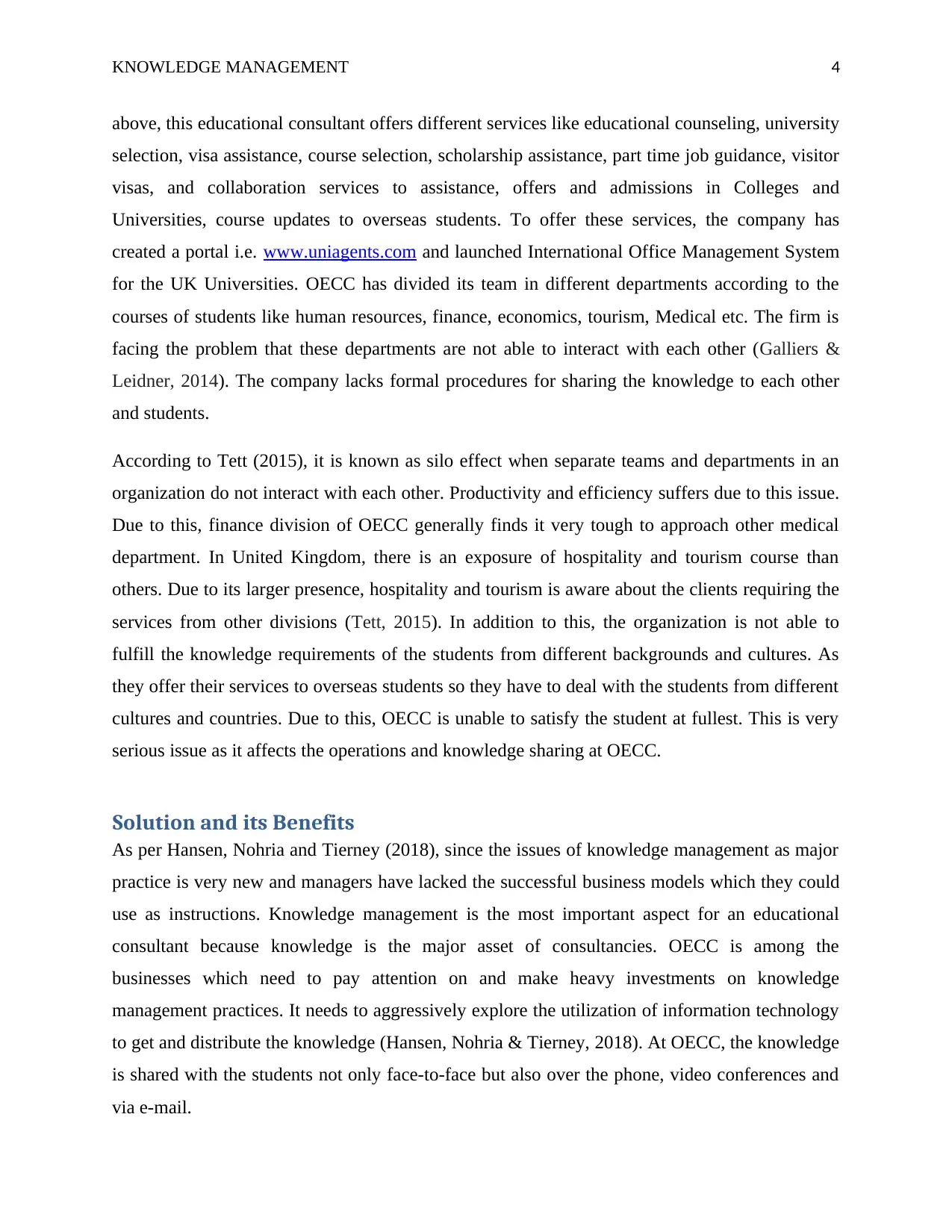
KNOWLEDGE MANAGEMENT 4
above, this educational consultant offers different services like educational counseling, university
selection, visa assistance, course selection, scholarship assistance, part time job guidance, visitor
visas, and collaboration services to assistance, offers and admissions in Colleges and
Universities, course updates to overseas students. To offer these services, the company has
created a portal i.e. www.uniagents.com and launched International Office Management System
for the UK Universities. OECC has divided its team in different departments according to the
courses of students like human resources, finance, economics, tourism, Medical etc. The firm is
facing the problem that these departments are not able to interact with each other (Galliers &
Leidner, 2014). The company lacks formal procedures for sharing the knowledge to each other
and students.
According to Tett (2015), it is known as silo effect when separate teams and departments in an
organization do not interact with each other. Productivity and efficiency suffers due to this issue.
Due to this, finance division of OECC generally finds it very tough to approach other medical
department. In United Kingdom, there is an exposure of hospitality and tourism course than
others. Due to its larger presence, hospitality and tourism is aware about the clients requiring the
services from other divisions (Tett, 2015). In addition to this, the organization is not able to
fulfill the knowledge requirements of the students from different backgrounds and cultures. As
they offer their services to overseas students so they have to deal with the students from different
cultures and countries. Due to this, OECC is unable to satisfy the student at fullest. This is very
serious issue as it affects the operations and knowledge sharing at OECC.
Solution and its Benefits
As per Hansen, Nohria and Tierney (2018), since the issues of knowledge management as major
practice is very new and managers have lacked the successful business models which they could
use as instructions. Knowledge management is the most important aspect for an educational
consultant because knowledge is the major asset of consultancies. OECC is among the
businesses which need to pay attention on and make heavy investments on knowledge
management practices. It needs to aggressively explore the utilization of information technology
to get and distribute the knowledge (Hansen, Nohria & Tierney, 2018). At OECC, the knowledge
is shared with the students not only face-to-face but also over the phone, video conferences and
via e-mail.
above, this educational consultant offers different services like educational counseling, university
selection, visa assistance, course selection, scholarship assistance, part time job guidance, visitor
visas, and collaboration services to assistance, offers and admissions in Colleges and
Universities, course updates to overseas students. To offer these services, the company has
created a portal i.e. www.uniagents.com and launched International Office Management System
for the UK Universities. OECC has divided its team in different departments according to the
courses of students like human resources, finance, economics, tourism, Medical etc. The firm is
facing the problem that these departments are not able to interact with each other (Galliers &
Leidner, 2014). The company lacks formal procedures for sharing the knowledge to each other
and students.
According to Tett (2015), it is known as silo effect when separate teams and departments in an
organization do not interact with each other. Productivity and efficiency suffers due to this issue.
Due to this, finance division of OECC generally finds it very tough to approach other medical
department. In United Kingdom, there is an exposure of hospitality and tourism course than
others. Due to its larger presence, hospitality and tourism is aware about the clients requiring the
services from other divisions (Tett, 2015). In addition to this, the organization is not able to
fulfill the knowledge requirements of the students from different backgrounds and cultures. As
they offer their services to overseas students so they have to deal with the students from different
cultures and countries. Due to this, OECC is unable to satisfy the student at fullest. This is very
serious issue as it affects the operations and knowledge sharing at OECC.
Solution and its Benefits
As per Hansen, Nohria and Tierney (2018), since the issues of knowledge management as major
practice is very new and managers have lacked the successful business models which they could
use as instructions. Knowledge management is the most important aspect for an educational
consultant because knowledge is the major asset of consultancies. OECC is among the
businesses which need to pay attention on and make heavy investments on knowledge
management practices. It needs to aggressively explore the utilization of information technology
to get and distribute the knowledge (Hansen, Nohria & Tierney, 2018). At OECC, the knowledge
is shared with the students not only face-to-face but also over the phone, video conferences and
via e-mail.
Paraphrase This Document
Need a fresh take? Get an instant paraphrase of this document with our AI Paraphraser
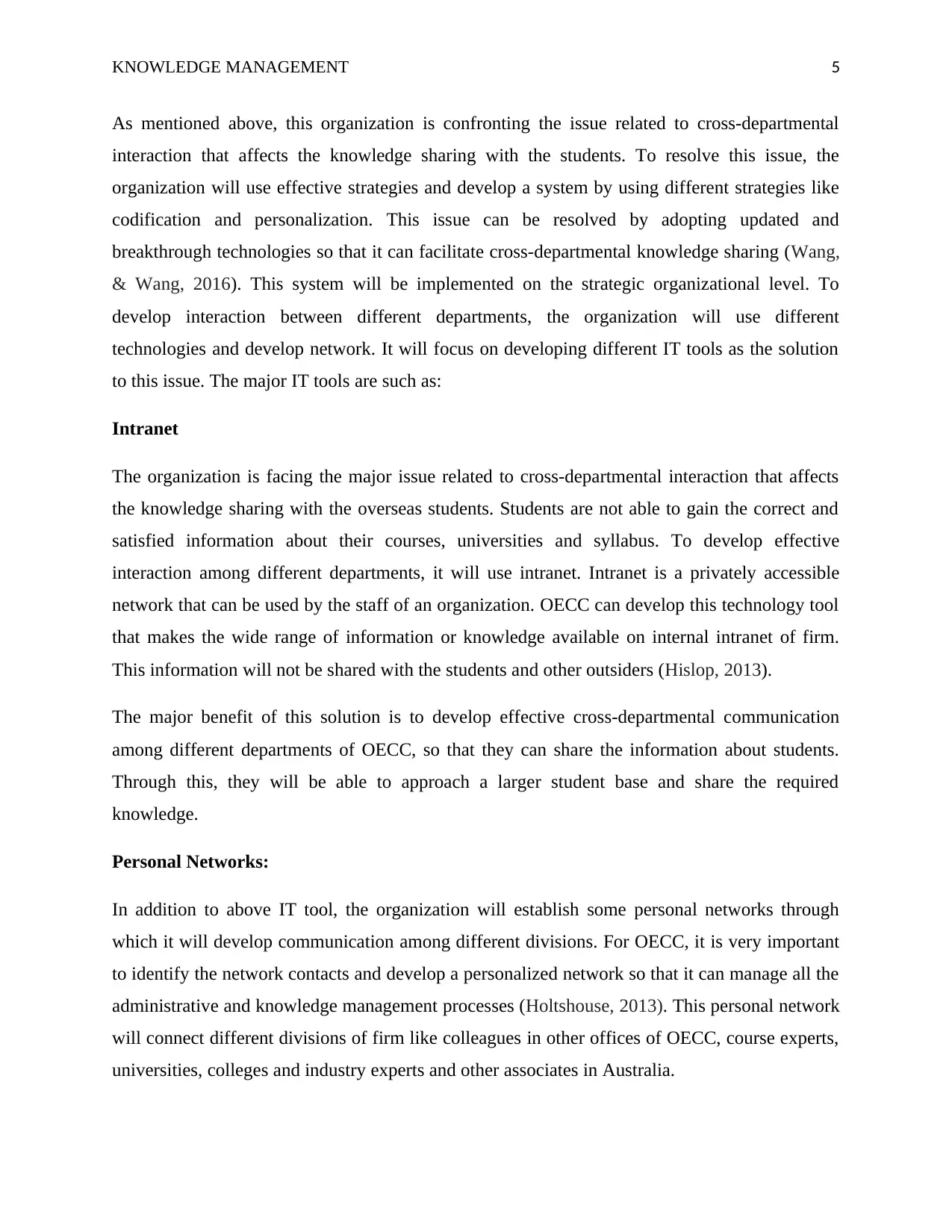
KNOWLEDGE MANAGEMENT 5
As mentioned above, this organization is confronting the issue related to cross-departmental
interaction that affects the knowledge sharing with the students. To resolve this issue, the
organization will use effective strategies and develop a system by using different strategies like
codification and personalization. This issue can be resolved by adopting updated and
breakthrough technologies so that it can facilitate cross-departmental knowledge sharing (Wang,
& Wang, 2016). This system will be implemented on the strategic organizational level. To
develop interaction between different departments, the organization will use different
technologies and develop network. It will focus on developing different IT tools as the solution
to this issue. The major IT tools are such as:
Intranet
The organization is facing the major issue related to cross-departmental interaction that affects
the knowledge sharing with the overseas students. Students are not able to gain the correct and
satisfied information about their courses, universities and syllabus. To develop effective
interaction among different departments, it will use intranet. Intranet is a privately accessible
network that can be used by the staff of an organization. OECC can develop this technology tool
that makes the wide range of information or knowledge available on internal intranet of firm.
This information will not be shared with the students and other outsiders (Hislop, 2013).
The major benefit of this solution is to develop effective cross-departmental communication
among different departments of OECC, so that they can share the information about students.
Through this, they will be able to approach a larger student base and share the required
knowledge.
Personal Networks:
In addition to above IT tool, the organization will establish some personal networks through
which it will develop communication among different divisions. For OECC, it is very important
to identify the network contacts and develop a personalized network so that it can manage all the
administrative and knowledge management processes (Holtshouse, 2013). This personal network
will connect different divisions of firm like colleagues in other offices of OECC, course experts,
universities, colleges and industry experts and other associates in Australia.
As mentioned above, this organization is confronting the issue related to cross-departmental
interaction that affects the knowledge sharing with the students. To resolve this issue, the
organization will use effective strategies and develop a system by using different strategies like
codification and personalization. This issue can be resolved by adopting updated and
breakthrough technologies so that it can facilitate cross-departmental knowledge sharing (Wang,
& Wang, 2016). This system will be implemented on the strategic organizational level. To
develop interaction between different departments, the organization will use different
technologies and develop network. It will focus on developing different IT tools as the solution
to this issue. The major IT tools are such as:
Intranet
The organization is facing the major issue related to cross-departmental interaction that affects
the knowledge sharing with the overseas students. Students are not able to gain the correct and
satisfied information about their courses, universities and syllabus. To develop effective
interaction among different departments, it will use intranet. Intranet is a privately accessible
network that can be used by the staff of an organization. OECC can develop this technology tool
that makes the wide range of information or knowledge available on internal intranet of firm.
This information will not be shared with the students and other outsiders (Hislop, 2013).
The major benefit of this solution is to develop effective cross-departmental communication
among different departments of OECC, so that they can share the information about students.
Through this, they will be able to approach a larger student base and share the required
knowledge.
Personal Networks:
In addition to above IT tool, the organization will establish some personal networks through
which it will develop communication among different divisions. For OECC, it is very important
to identify the network contacts and develop a personalized network so that it can manage all the
administrative and knowledge management processes (Holtshouse, 2013). This personal network
will connect different divisions of firm like colleagues in other offices of OECC, course experts,
universities, colleges and industry experts and other associates in Australia.
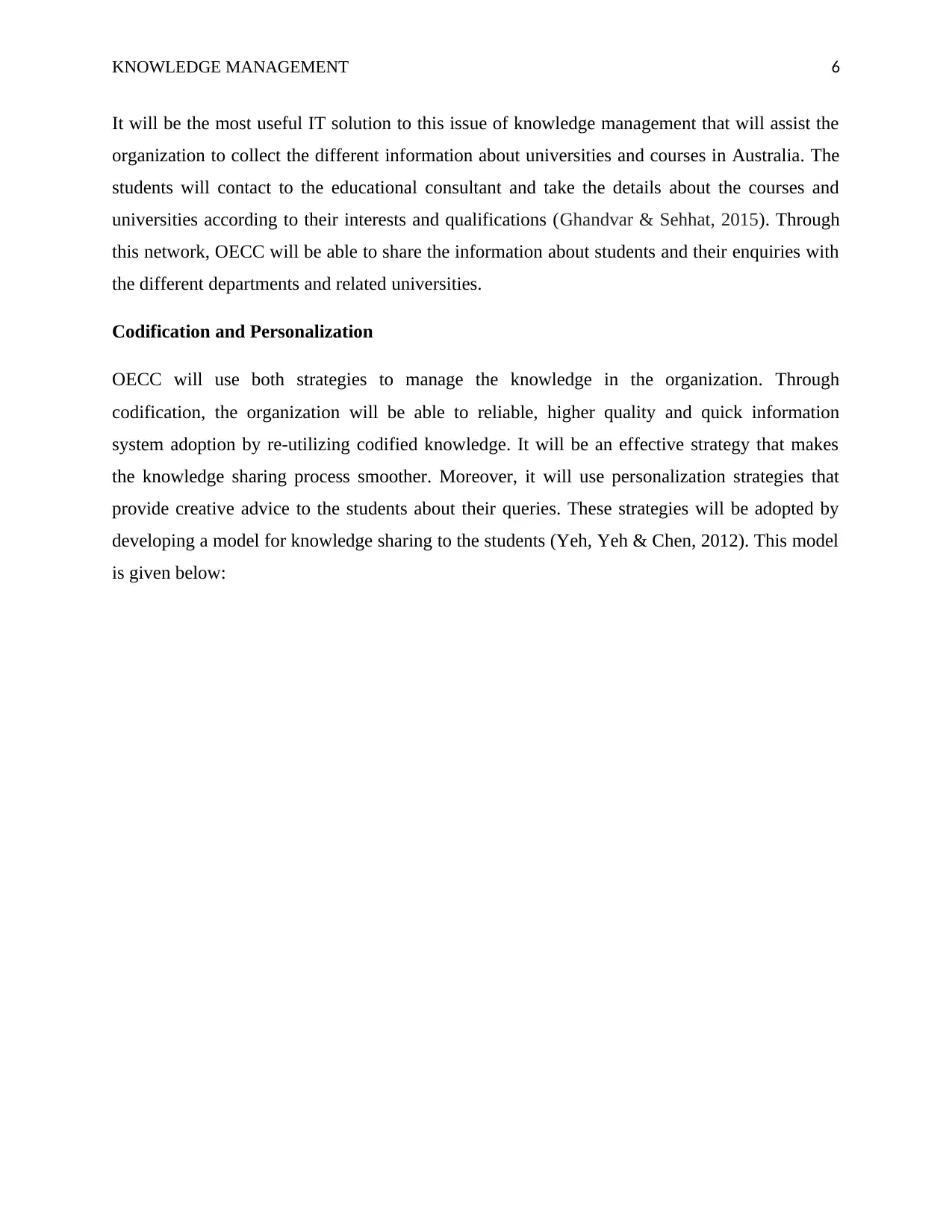
KNOWLEDGE MANAGEMENT 6
It will be the most useful IT solution to this issue of knowledge management that will assist the
organization to collect the different information about universities and courses in Australia. The
students will contact to the educational consultant and take the details about the courses and
universities according to their interests and qualifications (Ghandvar & Sehhat, 2015). Through
this network, OECC will be able to share the information about students and their enquiries with
the different departments and related universities.
Codification and Personalization
OECC will use both strategies to manage the knowledge in the organization. Through
codification, the organization will be able to reliable, higher quality and quick information
system adoption by re-utilizing codified knowledge. It will be an effective strategy that makes
the knowledge sharing process smoother. Moreover, it will use personalization strategies that
provide creative advice to the students about their queries. These strategies will be adopted by
developing a model for knowledge sharing to the students (Yeh, Yeh & Chen, 2012). This model
is given below:
It will be the most useful IT solution to this issue of knowledge management that will assist the
organization to collect the different information about universities and courses in Australia. The
students will contact to the educational consultant and take the details about the courses and
universities according to their interests and qualifications (Ghandvar & Sehhat, 2015). Through
this network, OECC will be able to share the information about students and their enquiries with
the different departments and related universities.
Codification and Personalization
OECC will use both strategies to manage the knowledge in the organization. Through
codification, the organization will be able to reliable, higher quality and quick information
system adoption by re-utilizing codified knowledge. It will be an effective strategy that makes
the knowledge sharing process smoother. Moreover, it will use personalization strategies that
provide creative advice to the students about their queries. These strategies will be adopted by
developing a model for knowledge sharing to the students (Yeh, Yeh & Chen, 2012). This model
is given below:
⊘ This is a preview!⊘
Do you want full access?
Subscribe today to unlock all pages.

Trusted by 1+ million students worldwide
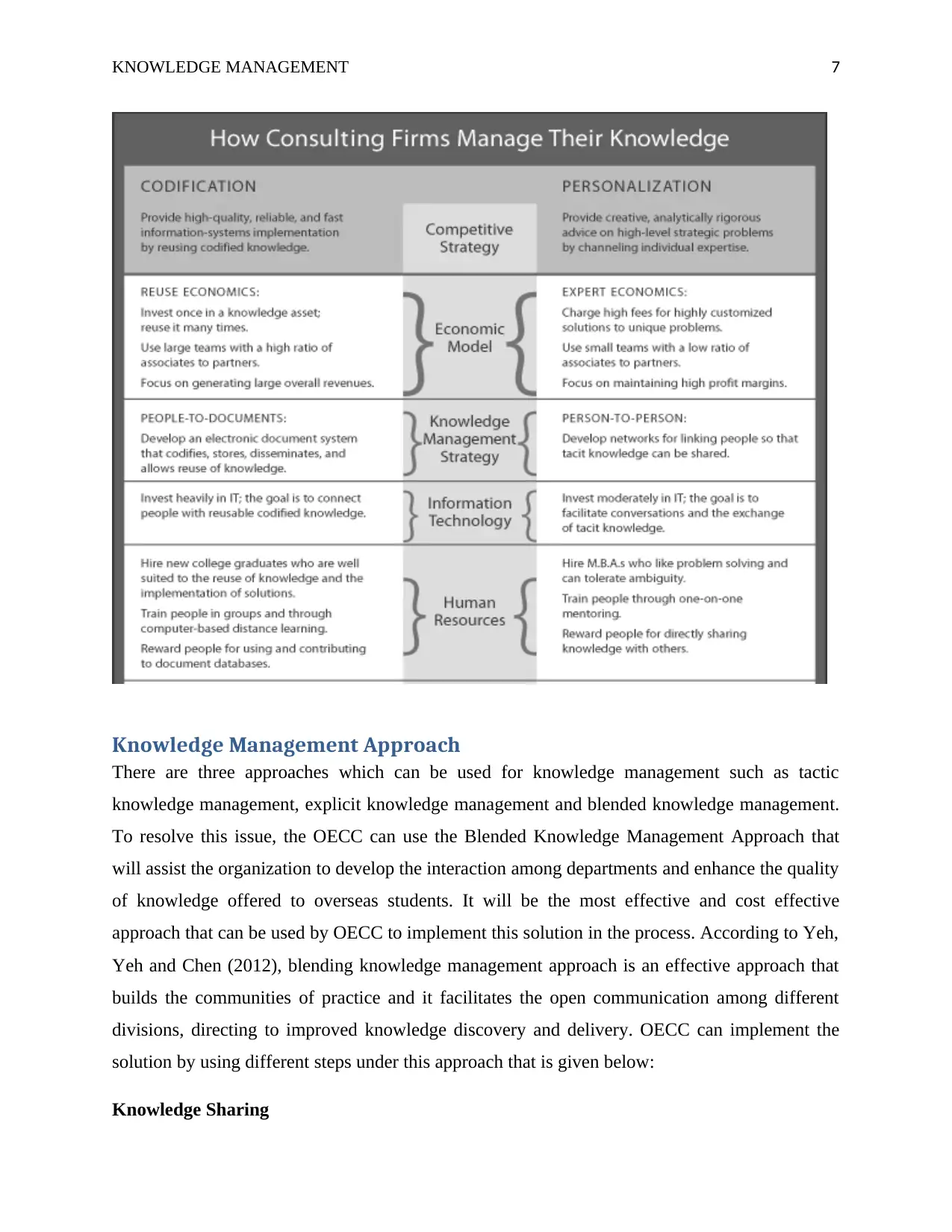
KNOWLEDGE MANAGEMENT 7
Knowledge Management Approach
There are three approaches which can be used for knowledge management such as tactic
knowledge management, explicit knowledge management and blended knowledge management.
To resolve this issue, the OECC can use the Blended Knowledge Management Approach that
will assist the organization to develop the interaction among departments and enhance the quality
of knowledge offered to overseas students. It will be the most effective and cost effective
approach that can be used by OECC to implement this solution in the process. According to Yeh,
Yeh and Chen (2012), blending knowledge management approach is an effective approach that
builds the communities of practice and it facilitates the open communication among different
divisions, directing to improved knowledge discovery and delivery. OECC can implement the
solution by using different steps under this approach that is given below:
Knowledge Sharing
Knowledge Management Approach
There are three approaches which can be used for knowledge management such as tactic
knowledge management, explicit knowledge management and blended knowledge management.
To resolve this issue, the OECC can use the Blended Knowledge Management Approach that
will assist the organization to develop the interaction among departments and enhance the quality
of knowledge offered to overseas students. It will be the most effective and cost effective
approach that can be used by OECC to implement this solution in the process. According to Yeh,
Yeh and Chen (2012), blending knowledge management approach is an effective approach that
builds the communities of practice and it facilitates the open communication among different
divisions, directing to improved knowledge discovery and delivery. OECC can implement the
solution by using different steps under this approach that is given below:
Knowledge Sharing
Paraphrase This Document
Need a fresh take? Get an instant paraphrase of this document with our AI Paraphraser
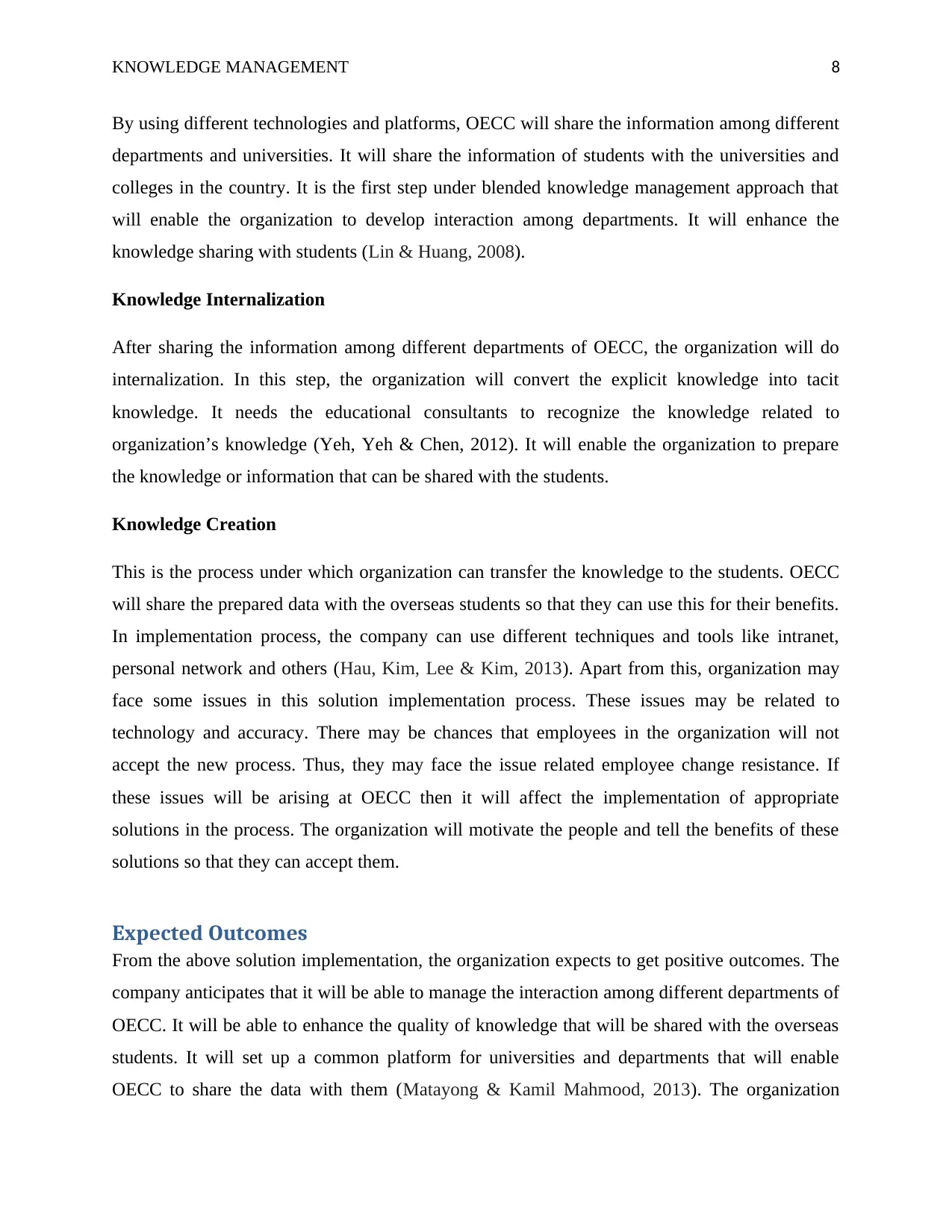
KNOWLEDGE MANAGEMENT 8
By using different technologies and platforms, OECC will share the information among different
departments and universities. It will share the information of students with the universities and
colleges in the country. It is the first step under blended knowledge management approach that
will enable the organization to develop interaction among departments. It will enhance the
knowledge sharing with students (Lin & Huang, 2008).
Knowledge Internalization
After sharing the information among different departments of OECC, the organization will do
internalization. In this step, the organization will convert the explicit knowledge into tacit
knowledge. It needs the educational consultants to recognize the knowledge related to
organization’s knowledge (Yeh, Yeh & Chen, 2012). It will enable the organization to prepare
the knowledge or information that can be shared with the students.
Knowledge Creation
This is the process under which organization can transfer the knowledge to the students. OECC
will share the prepared data with the overseas students so that they can use this for their benefits.
In implementation process, the company can use different techniques and tools like intranet,
personal network and others (Hau, Kim, Lee & Kim, 2013). Apart from this, organization may
face some issues in this solution implementation process. These issues may be related to
technology and accuracy. There may be chances that employees in the organization will not
accept the new process. Thus, they may face the issue related employee change resistance. If
these issues will be arising at OECC then it will affect the implementation of appropriate
solutions in the process. The organization will motivate the people and tell the benefits of these
solutions so that they can accept them.
Expected Outcomes
From the above solution implementation, the organization expects to get positive outcomes. The
company anticipates that it will be able to manage the interaction among different departments of
OECC. It will be able to enhance the quality of knowledge that will be shared with the overseas
students. It will set up a common platform for universities and departments that will enable
OECC to share the data with them (Matayong & Kamil Mahmood, 2013). The organization
By using different technologies and platforms, OECC will share the information among different
departments and universities. It will share the information of students with the universities and
colleges in the country. It is the first step under blended knowledge management approach that
will enable the organization to develop interaction among departments. It will enhance the
knowledge sharing with students (Lin & Huang, 2008).
Knowledge Internalization
After sharing the information among different departments of OECC, the organization will do
internalization. In this step, the organization will convert the explicit knowledge into tacit
knowledge. It needs the educational consultants to recognize the knowledge related to
organization’s knowledge (Yeh, Yeh & Chen, 2012). It will enable the organization to prepare
the knowledge or information that can be shared with the students.
Knowledge Creation
This is the process under which organization can transfer the knowledge to the students. OECC
will share the prepared data with the overseas students so that they can use this for their benefits.
In implementation process, the company can use different techniques and tools like intranet,
personal network and others (Hau, Kim, Lee & Kim, 2013). Apart from this, organization may
face some issues in this solution implementation process. These issues may be related to
technology and accuracy. There may be chances that employees in the organization will not
accept the new process. Thus, they may face the issue related employee change resistance. If
these issues will be arising at OECC then it will affect the implementation of appropriate
solutions in the process. The organization will motivate the people and tell the benefits of these
solutions so that they can accept them.
Expected Outcomes
From the above solution implementation, the organization expects to get positive outcomes. The
company anticipates that it will be able to manage the interaction among different departments of
OECC. It will be able to enhance the quality of knowledge that will be shared with the overseas
students. It will set up a common platform for universities and departments that will enable
OECC to share the data with them (Matayong & Kamil Mahmood, 2013). The organization
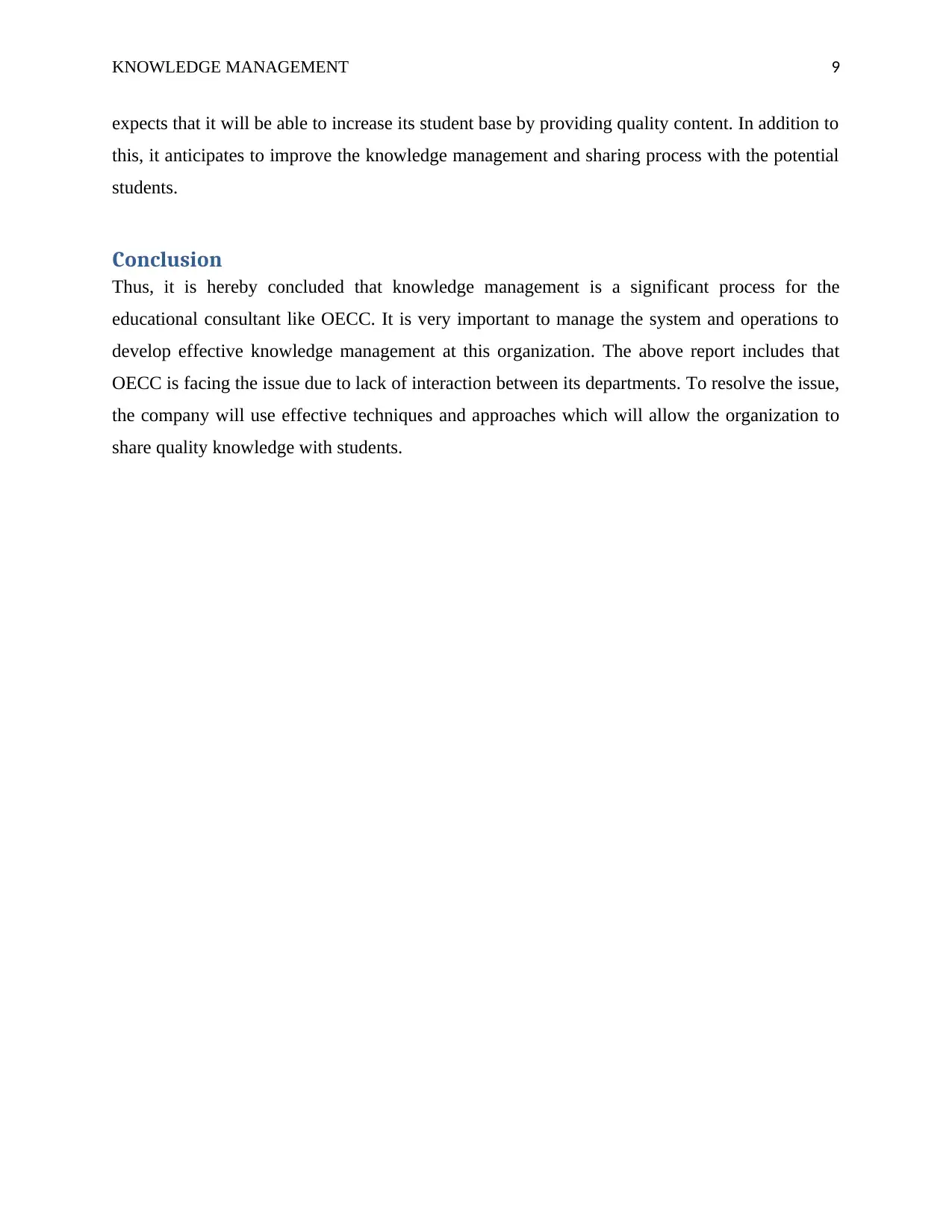
KNOWLEDGE MANAGEMENT 9
expects that it will be able to increase its student base by providing quality content. In addition to
this, it anticipates to improve the knowledge management and sharing process with the potential
students.
Conclusion
Thus, it is hereby concluded that knowledge management is a significant process for the
educational consultant like OECC. It is very important to manage the system and operations to
develop effective knowledge management at this organization. The above report includes that
OECC is facing the issue due to lack of interaction between its departments. To resolve the issue,
the company will use effective techniques and approaches which will allow the organization to
share quality knowledge with students.
expects that it will be able to increase its student base by providing quality content. In addition to
this, it anticipates to improve the knowledge management and sharing process with the potential
students.
Conclusion
Thus, it is hereby concluded that knowledge management is a significant process for the
educational consultant like OECC. It is very important to manage the system and operations to
develop effective knowledge management at this organization. The above report includes that
OECC is facing the issue due to lack of interaction between its departments. To resolve the issue,
the company will use effective techniques and approaches which will allow the organization to
share quality knowledge with students.
⊘ This is a preview!⊘
Do you want full access?
Subscribe today to unlock all pages.

Trusted by 1+ million students worldwide
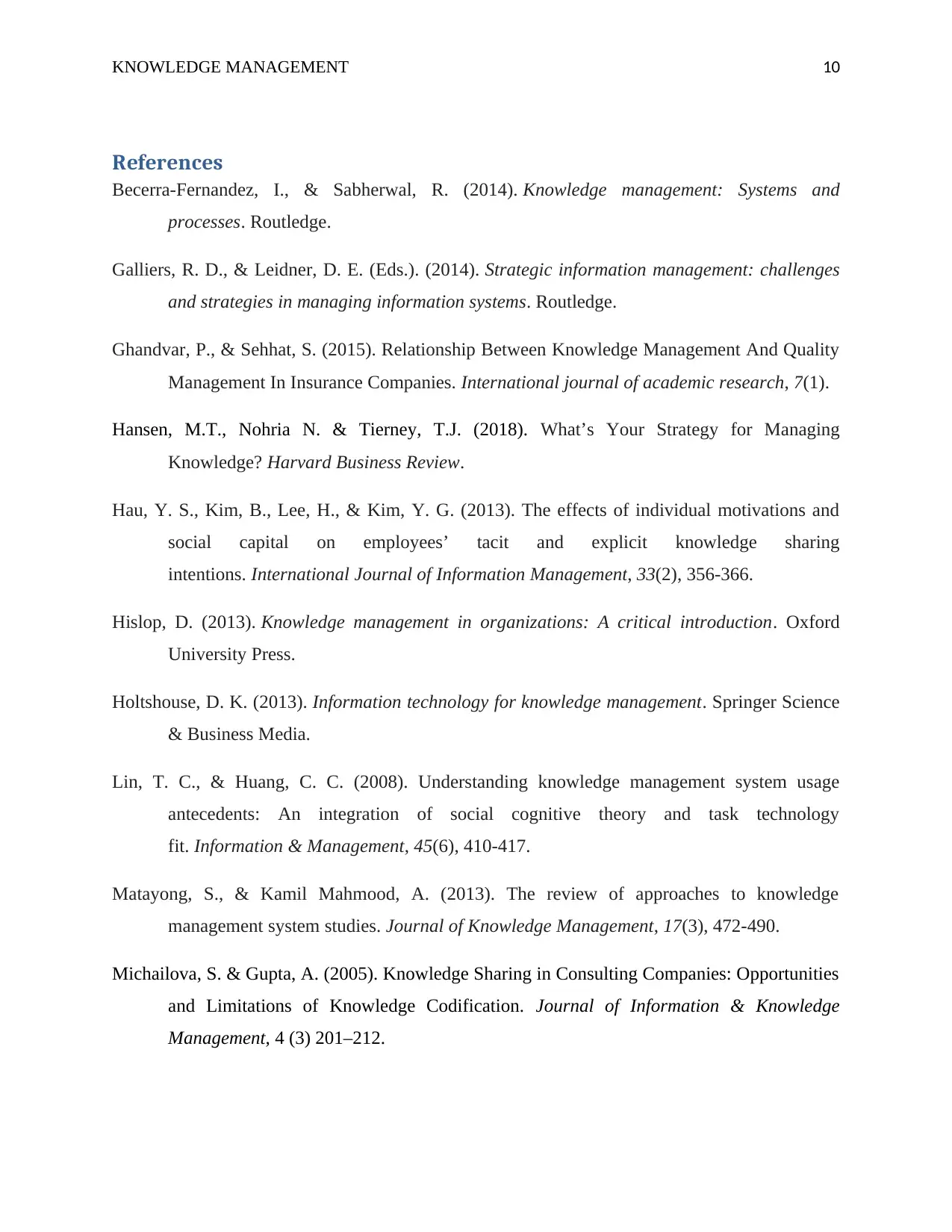
KNOWLEDGE MANAGEMENT 10
References
Becerra-Fernandez, I., & Sabherwal, R. (2014). Knowledge management: Systems and
processes. Routledge.
Galliers, R. D., & Leidner, D. E. (Eds.). (2014). Strategic information management: challenges
and strategies in managing information systems. Routledge.
Ghandvar, P., & Sehhat, S. (2015). Relationship Between Knowledge Management And Quality
Management In Insurance Companies. International journal of academic research, 7(1).
Hansen, M.T., Nohria N. & Tierney, T.J. (2018). What’s Your Strategy for Managing
Knowledge? Harvard Business Review.
Hau, Y. S., Kim, B., Lee, H., & Kim, Y. G. (2013). The effects of individual motivations and
social capital on employees’ tacit and explicit knowledge sharing
intentions. International Journal of Information Management, 33(2), 356-366.
Hislop, D. (2013). Knowledge management in organizations: A critical introduction. Oxford
University Press.
Holtshouse, D. K. (2013). Information technology for knowledge management. Springer Science
& Business Media.
Lin, T. C., & Huang, C. C. (2008). Understanding knowledge management system usage
antecedents: An integration of social cognitive theory and task technology
fit. Information & Management, 45(6), 410-417.
Matayong, S., & Kamil Mahmood, A. (2013). The review of approaches to knowledge
management system studies. Journal of Knowledge Management, 17(3), 472-490.
Michailova, S. & Gupta, A. (2005). Knowledge Sharing in Consulting Companies: Opportunities
and Limitations of Knowledge Codification. Journal of Information & Knowledge
Management, 4 (3) 201–212.
References
Becerra-Fernandez, I., & Sabherwal, R. (2014). Knowledge management: Systems and
processes. Routledge.
Galliers, R. D., & Leidner, D. E. (Eds.). (2014). Strategic information management: challenges
and strategies in managing information systems. Routledge.
Ghandvar, P., & Sehhat, S. (2015). Relationship Between Knowledge Management And Quality
Management In Insurance Companies. International journal of academic research, 7(1).
Hansen, M.T., Nohria N. & Tierney, T.J. (2018). What’s Your Strategy for Managing
Knowledge? Harvard Business Review.
Hau, Y. S., Kim, B., Lee, H., & Kim, Y. G. (2013). The effects of individual motivations and
social capital on employees’ tacit and explicit knowledge sharing
intentions. International Journal of Information Management, 33(2), 356-366.
Hislop, D. (2013). Knowledge management in organizations: A critical introduction. Oxford
University Press.
Holtshouse, D. K. (2013). Information technology for knowledge management. Springer Science
& Business Media.
Lin, T. C., & Huang, C. C. (2008). Understanding knowledge management system usage
antecedents: An integration of social cognitive theory and task technology
fit. Information & Management, 45(6), 410-417.
Matayong, S., & Kamil Mahmood, A. (2013). The review of approaches to knowledge
management system studies. Journal of Knowledge Management, 17(3), 472-490.
Michailova, S. & Gupta, A. (2005). Knowledge Sharing in Consulting Companies: Opportunities
and Limitations of Knowledge Codification. Journal of Information & Knowledge
Management, 4 (3) 201–212.
Paraphrase This Document
Need a fresh take? Get an instant paraphrase of this document with our AI Paraphraser
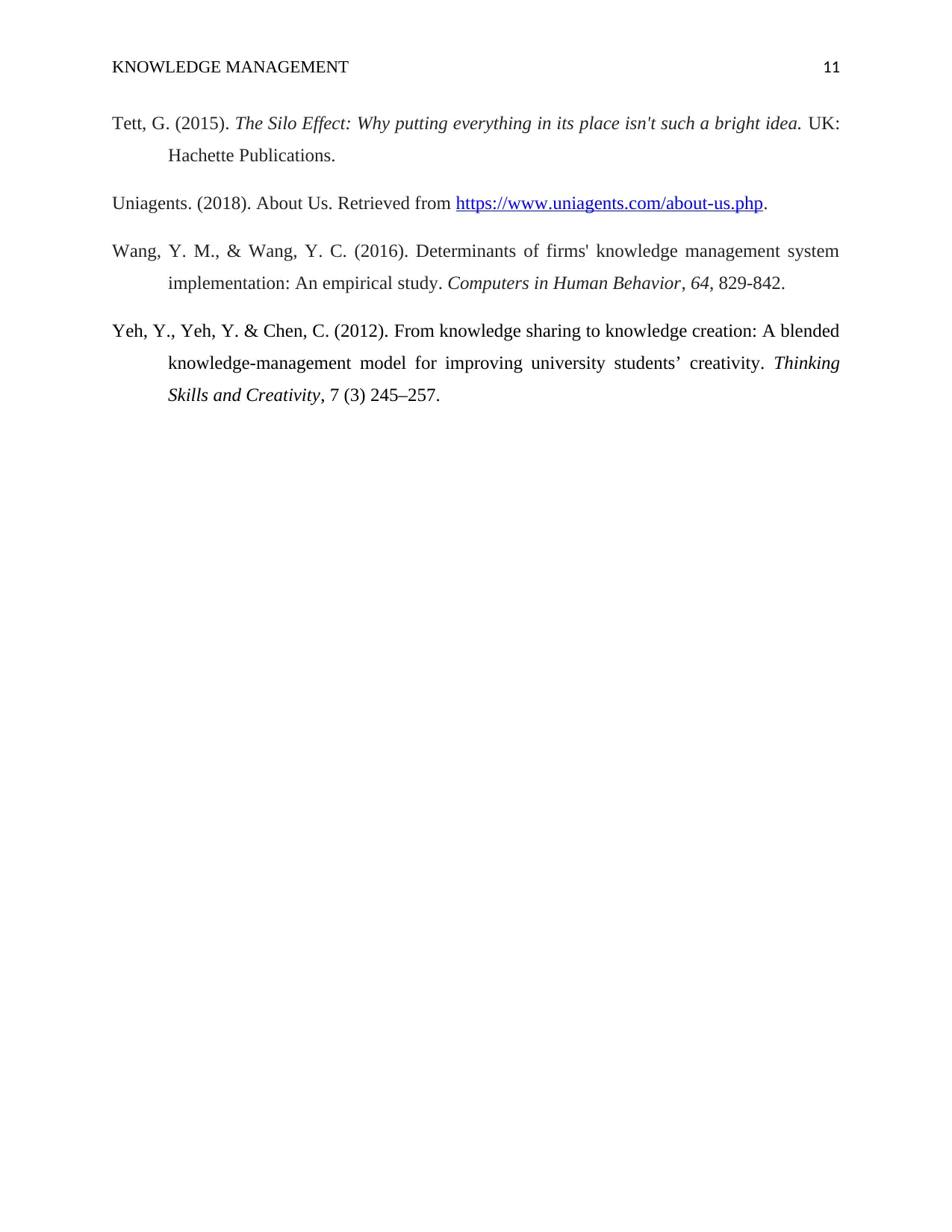
KNOWLEDGE MANAGEMENT 11
Tett, G. (2015). The Silo Effect: Why putting everything in its place isn't such a bright idea. UK:
Hachette Publications.
Uniagents. (2018). About Us. Retrieved from https://www.uniagents.com/about-us.php.
Wang, Y. M., & Wang, Y. C. (2016). Determinants of firms' knowledge management system
implementation: An empirical study. Computers in Human Behavior, 64, 829-842.
Yeh, Y., Yeh, Y. & Chen, C. (2012). From knowledge sharing to knowledge creation: A blended
knowledge-management model for improving university students’ creativity. Thinking
Skills and Creativity, 7 (3) 245–257.
Tett, G. (2015). The Silo Effect: Why putting everything in its place isn't such a bright idea. UK:
Hachette Publications.
Uniagents. (2018). About Us. Retrieved from https://www.uniagents.com/about-us.php.
Wang, Y. M., & Wang, Y. C. (2016). Determinants of firms' knowledge management system
implementation: An empirical study. Computers in Human Behavior, 64, 829-842.
Yeh, Y., Yeh, Y. & Chen, C. (2012). From knowledge sharing to knowledge creation: A blended
knowledge-management model for improving university students’ creativity. Thinking
Skills and Creativity, 7 (3) 245–257.
1 out of 11
Related Documents
Your All-in-One AI-Powered Toolkit for Academic Success.
+13062052269
info@desklib.com
Available 24*7 on WhatsApp / Email
![[object Object]](/_next/static/media/star-bottom.7253800d.svg)
Unlock your academic potential
Copyright © 2020–2025 A2Z Services. All Rights Reserved. Developed and managed by ZUCOL.




